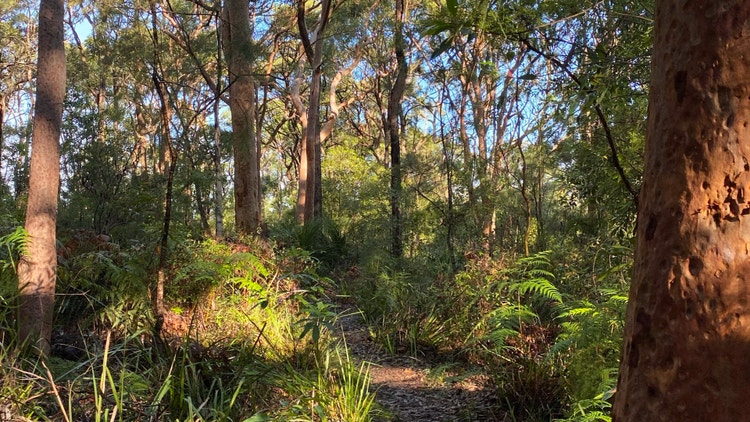

Program
This excursion covers Modules 1 and 4. Students will explore the geology and soil types of the Hawkesbury Sandstone landscape and its associated soils and vegetation at various sites. They’ll collect data using fieldwork and sampling techniques, process and analyse it to identify patterns between geology, ecology, and human impacts. This program focuses on Working Scientifically skills and supports a Depth Study.
Inquiry questions
- What is the dominant parent rock in the Field of Mars Reserve and how was it formed?
- What are the soil types at the Field of Mars Reserve and what are their component materials?
- What are the effects of introduced species on the environment at the Field of Mars Reserve?
Fieldwork
Rock and mineral study
Students closely observe Sydney sandstone in-situ using a hand lens to classify sediment properties such as grain size, class, sphericity, roundness and sorting.
Soil investigation
Students participate in a comparative study that investigates the differences between soil types in vegetation communities found on different parent materials. They will use fieldwork instruments to find out soil texture, pH, moisture and colour.
Impacts of introduced species - abiotic and biotic sampling
Students conduct another site comparison that measures the effects of introduced plants on the environment. At each site they will use fieldwork instruments and sampling techniques to collect first-hand data, such as vegetation structure and classification, canopy cover, air temperature, wind speed, humidity and light intensity.
Location

Field of Mars Reserve
Location information - including risk assessment and risk management advice, bus map and track overview.
Essential information
| Cost 2025 |
DoE school $26 per student – GST free Non-gov school $36 per student – GST free, minimum charge $750 |
| Cost 2026 |
DoE school $27 per student – GST free Non-gov school $37 per student – GST free, minimum charge $750 per class |
| Classes | Recommended maximum 2 classes. |
| Bring |
View Preparing for your excursion. Bring worksheet, writing materials, clipboard, medications, low-waste food, water bottles, sunblock, hat and raincoat in a backpack. Sports uniform recommended. This program requires students to use a mobile device to record data. Notify the centre if student phone usage is not permitted. |
| Welfare |
Rugged bushwalking, not wheelchair accessible. May not suit recently unwell participants. For medical or special needs notify staff prior to program. |
| Extreme or wet weather | Program may be modified, postponed or cancelled due to predicted extreme temperatures, bush fire danger, heavy rainfall, high winds or dust storms. |
| Booking policy | Confirm student numbers and classes 7 days in advance. |
| Cancellation fee |
Less than 30 working school days – $600 Less than 7 working school days notice – full cost Weather or fire danger cancellation – $0 |
| Worksheet |
Worksheet coming soon. Schools are responsible for printing student worksheets. |
| Module 1: Earth's resources | Earth's resources Google site |
| Module 4: Human impacts | |
| Additional resources | Fieldwork techniques |
| Time | Activities |
| 9.30 - 10.00 |
Introduction and fieldwork preparation Food break and toilets |
| 10.00 - 10.50 | Fieldwork activity 1 |
| 10.50 - 11.20 | Food break |
| 11.20 - 12.10 | Fieldwork activity 2 |
| 12.10 - 12.40 | Food break and toilets |
| 12.40 - 1.30 | Fieldwork activity 3 |
| 1.30 - 2.00 | Data processing and conclusions |
| 2.00 - 2.15 | Pack up and depart |
Stage 6 Earth and Environmental Science (2017)
Module 1 Earth's resources
Outcomes
A student:
- conducts investigations to collect valid and reliable primary and secondary data and information EES11/12-3
- selects and processes appropriate qualitative and quantitative data and information using a range of appropriate media EES11/12-4
- analyses and evaluates primary and secondary data and information EES11/12-5
- describes the key features of the Earth’s systems, including the geosphere, atmosphere, hydrosphere and biosphere and how they are interrelated EES11-8
Content
Rocks, Minerals and the Rock Cycle
Inquiry question: What are the components of rocks and soils?
Students:
- investigate the physical properties of minerals that are used to assist in classification
- investigate a range of rocks and minerals and classify samples using dichotomous keys
- explain the formation of rocks as characteristic assemblages of mineral crystals or grains that are formed through igneous, sedimentary and metamorphic processes, as part of the Rock Cycle
- explain the formation of soil in terms of the interaction of atmospheric, geologic, hydrologic and biotic processes
- conduct a practical investigation to examine soil types and component materials
Module 4 Human impacts
Outcomes
A student:
- develops and evaluates questions and hypotheses for scientific investigation EES11/12-1
- designs and evaluates investigations in order to obtain primary and secondary data and information EES11/12-2
- conducts investigations to collect valid and reliable primary and secondary data and information EES11/12-3
- describes human impact on the Earth in relation to hydrological processes, geological processes and biological changes EES11-11
Content
Effects of Introduced Species
Inquiry question: How do introduced species affect the Australian environment and ecosystems?
Students:
-
outline the biotic and abiotic effects of introduced species
-
conduct an investigation into a local introduced species, including:
- reason for introducing the species
- biotic and abiotic effects of the species
- area affected by the species
- human impacts that favour the introduced species
Earth and Environmental Science Stage 6 Syllabus © NSW Education Standards Authority (NESA) for and on behalf of the Crown in right of the State of New South Wales, 2017



